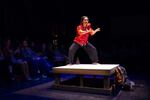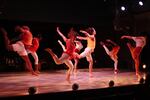When her mom first took Subashini Ganesan to dance class, she was tiny.

Subashini Ganesan performing at PICA's 2015 TBA Festival.
Chelsea Petraki / Courtesy of Subashini Ganesan
“I started dancing Bharathanatyam when I was 4-and-a-half-years old,” she said.
Her family, with roots in India, was living in Singapore at the time. She was learning the classical Indian form of Bharathanatyam — traditionally performed by women, usually in a temple setting. As a form, it’s loaded with nuance. The simplest gesture can tell you the difference between a brother or sister in a narrative; a poor man or a king.
“It’s something about that dance form really connected me to my body,” she said. “It wasn’t political. It was joyous, it was community-building. I danced with my friends in school. I wasn’t different.”
Then Ganesan moved to the U.S. for college and discovered a place where little girls take ballet, not traditional Indian dance. And she started feeling the assumptions piling on. People showed a reverence for her as a carrier of several thousand years of tradition. When in fact, she said, “I just do this because I love it.”

A performance from Natya Leela, the classical Indian dance school Ganesan founded
Eric Nordstrom / Courtesy of Subashini Ganesan
She continues to dance Bharathanatyam and teaches others to do so at
the Portland-based classical Indian dance school she founded
, but the original works she creates are much more contemporary — and
her passion has been helping others who are seeking homes for modern dance projects.
Ganesan and choreographer Oluyinka Akinjiola present
in Portland on Inauguration weekend. It’s a program of new work developed within the New Expressive Works Residency Ganesan developed.
Ganesan’s “Bliss and Other Easy Things” carries some of the trappings of Bharathanatyam (highly precise hand gestures and percussive use of feet), but the ensemble of all-female performers isn’t bound to the tightly structured classical forms. Ganesan said the work is a half-hour description bliss as cyclical state, rather than the apex of a journey, “Something beyond having margaritas on a beach”.

A 2016 performance from Oluyinka Akinjiola's REJOICE Diaspora Dance Theater.
Cameron Ousley / Courtesy of Oluyinka Akinjiola
Akinjiola’s “IBUKUN” is a work of pure joy, inspired by the Nigerian Yoruba funeral ceremonies she witnessed for her late grandmother, for whom the piece is named. “It’s really 10 days celebrating the person’s life,” she said. Different stages capture a viewing, a procession, then celebration.
That these works would be performed concurrent with the U.S.’s most formal public ceremonies, on inauguration weekend, was an accident of timing. But both Ganesan and Akinjiola said the juxtaposition deepened their dive into the work. Both are immigrants. Ganesan said she’s asking herself, “What does it mean to be standing with your heart open, upright, and experiencing what’s going to happen on the 20th of January and beyond. It’s something I think about every day now.
“For many of the people in my cast [for the show],” Akinjiola said, “a large part of our adulthood played out under the Obama administration. It felt like something heavy has passed. We’re figuring out how to transition in a positive way, and make this transition in our lives.”
Both choreographers also share a sense of balancing expectations and preconceptions from audiences and peers about whether their work, steeped in traditional sensibilities, can truly be contemporary.
“I’ve always been in these two worlds,” Akinjola said. “And through all the transitions I make as a contemporary choreographer, I still often find I’m labelled ‘African Dance.’”
“The question, ‘How is your work contemporary?’ is not asked,” says Ganesan. “I’d love to be asked that question!”
“When the question isn’t asked,” Akinjiola adds, “it has consequences. It’s a disservice to those who research and preserve traditional art forms.”
IGNITE takes place at New Expressive Works
, Studio2 in Southeast Portland Jan. 20-22.